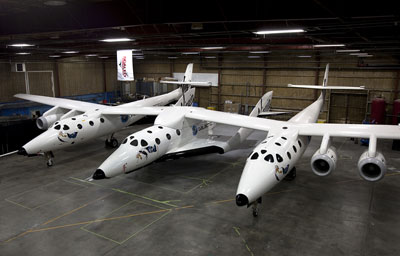SpaceShipTwo and the modern imaginationby Taylor Dinerman
|
| Will space tourists see the essential unity of the planet or will they see a frail collection of human societies that can barely hold themselves together? |
Mass tourism changed the way people saw the world. Suddenly there were millions of people all over the world who had at least some small exposure to other lands and other cultures. This made it hard for dictators and xenophobes to delude very large numbers of people into hating a disembodied enemy. It also allowed people to observe the nasty unpleasant habits of “those foreigners” and helped convince them that “they”, whoever “they” were, are simply “not one of us”.
Frank White’s 1987 book The Overview Effect speculated on what changes in human consciousness would result from human spaceflight. Part of the problem was that the remarkable experience of looking down at Earth was limited to a few astronauts and cosmonauts, all of whom were, one way or another, government employees. Since then a few private individuals have paid their own way into orbit. Some of them, such as Mark Shuttleworth, Greg Olsen, and Anousheh Ansari, have been able to relate their experiences to the public in ways that the professional space travelers cannot match. It is easier for ordinary folks to identify with someone who bought a ticket—no matter how expensive—than with a highly-trained expert who has to devote his or her whole life to this pursuit.
Once the experience of suborbital flight is shared by ten of thousands of paying customers, something in our global culture will change. It is impossible to know what the nature of this change will be. It may be as banal as the impact of cheap holidays in Spain was on the British middle class in the 1960s, or it may be as profound as the rage for pilgrimages was in Medieval Europe.
Will people see the essential unity of the planet or will they see a frail collection of human societies that can barely hold themselves together? In June 1985 the US hosted a Saudi prince on a space shuttle flight. He supposedly said that, “From space you cannot see any borders.” In the Middle East, thanks to unequal levels of irrigation, borders are often quite evident from space. In the Far East there is the famous image taken from space of a totally dark North Korea next to a brilliantly lit South as well as nearby Japan and China.
For Scaled Composites and Virgin Galactic the biggest question is going to be how many customers can they attract. If the experience is truly extraordinary, then the sales prospects will be equally extraordinary, even in a less-than-vibrant world economy. If it is seen as just another form of adventure tourism, then human suborbital spaceflight will be a small, specialized operation that can barely pay its way, like the now-grounded Concorde supersonic transport.
| If the first ten thousand Virgin Galactic customers come away feeling not only that the $200,000 price tag was worth it, but that they have gained a unique, life-changing perspective, then the business model will have worked. |
Virgin’s marketing skills cannot be doubted, but even the best sales operation must have a good product. In this case a ticket will buy access to a realm that few humans have ever visited. The first passengers will return from their trips to the edge of space and, if all goes well, they will probably give the firm the single most valuable form of advertising there is: word of mouth. If, however, they are badly prepared and if the experience is too much like a military operation or a school trip, then the negative message will quickly spread.
If all does goes well then things will truly get interesting and the demand will lead to a whole new set of competitors and investors. While Scaled Composites would find it fairly easy to finance a SpaceShipThree, others, such as XCOR with its Lynx vehicle, could find new sources of money to build follow on vehicles.
By the latter half of the next decade the performance of the suborbital craft could reach close to orbital speeds. This could, around the year 2020 or 2025, lead to a breakthrough system that could take passengers and cargo into orbit for far less than today’s cost. Ultra-lightweight materials that are now being developed may turn out to be the critical technology.
So, if the first ten thousand Virgin Galactic customers come away feeling not only that the $200,000 price tag was worth it, but that they have gained a unique, life-changing perspective, then the business model will have worked. If, though, they end up feeling that they have been browbeaten into a single, approved way of thinking about their experience, then their resentment will wreck the industry before it has been given a real chance to prove itself.
Commercial suborbital spaceflight is an opportunity for a large number of humans to see themselves and the world differently. It should unleash unexpected and unusual forms of creativity. If the promoters of the business try too hard to shape the intellectual and emotional aspects of the experience, they will end up creating a group of people who will provide negative word-of-mouth.
